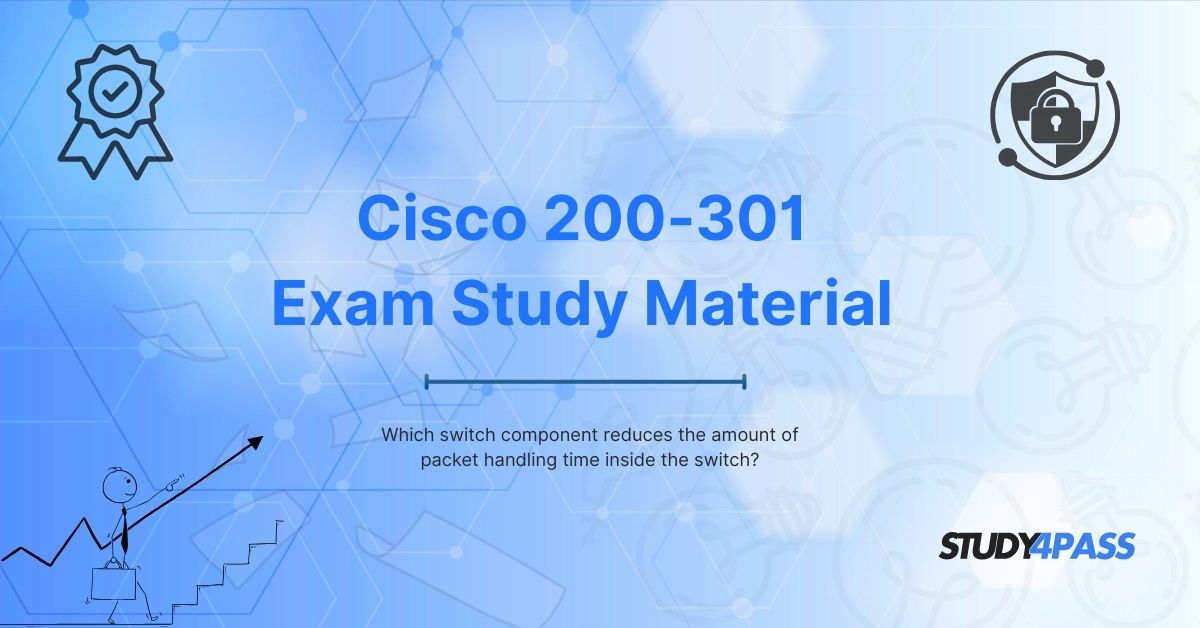Introduction
In modern networking, switches play a crucial role in efficiently forwarding data packets across networks. One of the key performance metrics for switches is packet handling time, which determines how quickly a switch can process and forward incoming packets. Several internal components influence this process, but one stands out for significantly reducing latency: the ASIC (Application-Specific Integrated Circuit).
This article explores how ASICs optimize packet handling time inside switches, their advantages over traditional CPU-based processing, and their relevance in Cisco certifications such as CCNA, CCDA, CCENT, CCNA Security, and CCNA Wireless. Additionally, we will discuss how Study4Pass provides high-quality study materials to help networking professionals master these concepts.
Understanding Packet Handling in Switches
Before diving into the specific component that reduces packet handling time, it's essential to understand how switches process packets.
1. Packet Switching Methods
Switches use different methods to forward packets:
- Store-and-Forward: The switch receives the entire packet, checks for errors, and then forwards it. This method ensures error-free transmission but introduces higher latency.
- Cut-Through: The switch begins forwarding the packet as soon as it reads the destination MAC address, reducing latency but potentially forwarding corrupted frames.
- Fragment-Free: A modified version of cut-through that checks the first 64 bytes (where collisions usually occur) before forwarding.
2. Factors Affecting Packet Handling Time
Several factors influence how quickly a switch processes packets:
- Switching Fabric: The internal architecture that connects ports.
- Buffer Memory: Stores packets during congestion.
- Forwarding Method: Cut-through is faster than store-and-forward.
- Hardware Acceleration: ASICs improve processing speed.
Among these, ASICs play the most critical role in reducing packet handling time.
ASIC: The Key Component Reducing Packet Handling Time
1. What is an ASIC?
An Application-Specific Integrated Circuit (ASIC) is a microchip designed for a specific function, such as packet switching. Unlike general-purpose CPUs, ASICs are optimized for high-speed data forwarding, making them ideal for switches.
2. How ASICs Reduce Packet Handling Time
ASICs enhance switching performance in several ways:
- Hardware-Based Forwarding: Unlike software-based processing (using a CPU), ASICs handle packet forwarding in hardware, drastically reducing latency.
- Parallel Processing: ASICs can process multiple packets simultaneously, improving throughput.
- Fixed-Function Logic: Since ASICs are designed solely for switching, they eliminate unnecessary processing overhead.
- CAM/TCAM Integration: ASICs often integrate Content Addressable Memory (CAM) and Ternary CAM (TCAM) for fast MAC and IP lookups.
3. ASIC vs. CPU-Based Switching
|
Feature |
ASIC-Based Switching |
CPU-Based Switching |
|
Speed |
Ultra-fast (nanoseconds) |
Slower (milliseconds) |
|
Scalability |
Handles high traffic efficiently |
Limited by CPU power |
|
Power Efficiency |
Low power consumption |
Higher power usage |
|
Flexibility |
Fixed functionality |
Programmable but slower |
ASICs are the preferred choice in enterprise and data center switches due to their speed and efficiency.
ASICs in Cisco Switches
Cisco leverages ASICs in its switches to ensure high-performance networking. Some key models include:
1. Cisco Catalyst Switches
- Use Cisco Unified Access Data Plane (UADP) ASICs for high-speed forwarding.
- Support features like Quality of Service (QoS), Access Control Lists (ACLs), and NetFlow without performance degradation.
2. Cisco Nexus Switches
- Utilize Cloud Scale ASICs for data center environments.
- Provide low-latency, high-throughput switching for cloud applications.
3. Cisco Meraki Switches
- Incorporate ASICs for SDN (Software-Defined Networking) optimizations.
Understanding ASIC technology is crucial for CCNA, CCNA Security, and CCNA Wireless candidates, as Cisco exams test knowledge of switch internals.
Why Study4Pass is the Best Resource for Cisco Certifications?
To master networking concepts like ASICs and switching technologies, Study4Pass offers the best study materials for Cisco certifications. Here’s why:
1. Comprehensive Study Guides
- Covers CCNA, CCDA, CCENT, CCNA Security, and CCNA Wireless in detail.
- Includes real-world examples and lab scenarios for better understanding.
2. Practice Exams with Explanations
- Simulates actual Cisco exam environments.
- Provides detailed explanations for correct and incorrect answers.
3. Up-to-Date Content
- Regularly updated to reflect the latest Cisco exam blueprints.
- Includes new technologies like SDN, IoT, and cloud networking.
4. Expert Instructors
- Courses designed by Cisco-certified professionals.
- Offers tips and tricks for passing exams on the first attempt.
5. Affordable Pricing
- High-quality resources at competitive prices.
- Free demos and sample questions available.
For anyone preparing for Cisco 200-301 CCNA or other certifications, Study4Pass is the ultimate study companion.
Conclusion
The ASIC (Application-Specific Integrated Circuit) is the primary switch component that reduces packet handling time by enabling hardware-based, high-speed forwarding. Unlike CPU-based processing, ASICs provide nanosecond-level latency, making them essential in modern switches from vendors like Cisco.
For networking professionals pursuing CCNA, CCDA, CCENT, CCNA Security, or CCNA Wireless, understanding ASICs and switching technologies is crucial. Study4Pass provides the best study materials, practice exams, and expert guidance to help you pass your Cisco exams with confidence.
Visit Study4Pass today and take the first step toward achieving your Cisco certification goals!
Special Discount: Offer Valid For Limited Time “200-301 Study Material”
Actual Exam Questions For Cisco's 200-301 Mock Test
Sample Questions For Cisco 200-301 Practice Exam
1. Which switch component helps in reducing the packet handling time inside the switch?
a) MAC Address Table
b) Power Supply Unit
c) Cooling Fan
d) LED Indicator
2. What feature of a switch minimizes the time taken to process packets internally?
a) VLAN Support
b) Port Mirroring
c) ASIC (Application-Specific Integrated Circuit)
d) PoE (Power over Ethernet)
3. Which technology allows switches to forward packets faster by using hardware-based processing?
a) Spanning Tree Protocol (STP)
b) Cut-Through Switching
c) Store-and-Forward Switching
d) Quality of Service (QoS)
4. What component in a switch helps in quick packet forwarding by storing destination MAC addresses?
a) CAM (Content Addressable Memory) Table
b) Flash Memory
c) Boot ROM
d) Buffer Memory
5. Which switching method reduces latency by forwarding packets before fully receiving them?
a) Cut-Through Switching
b) Store-and-Forward Switching
c) Fragment-Free Switching
d) Error-Checking Switching


